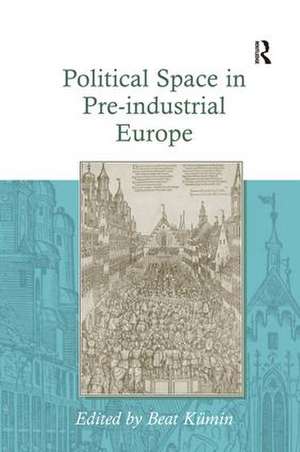Political Space in Pre-industrial Europe
Autor Beat Küminen Limba Engleză Hardback – 18 sep 2009
Preț: 1054.71 lei
Preț vechi: 1286.24 lei
-18% Nou
Puncte Express: 1582
Preț estimativ în valută:
201.81€ • 211.28$ • 166.99£
201.81€ • 211.28$ • 166.99£
Carte tipărită la comandă
Livrare economică 05-19 aprilie
Preluare comenzi: 021 569.72.76
Specificații
ISBN-13: 9780754660729
ISBN-10: 0754660729
Pagini: 296
Dimensiuni: 156 x 234 x 18 mm
Greutate: 0.45 kg
Ediția:1
Editura: Taylor & Francis
Colecția Routledge
Locul publicării:Oxford, United Kingdom
ISBN-10: 0754660729
Pagini: 296
Dimensiuni: 156 x 234 x 18 mm
Greutate: 0.45 kg
Ediția:1
Editura: Taylor & Francis
Colecția Routledge
Locul publicării:Oxford, United Kingdom
Notă biografică
Professor Beat Kümin is Director of Research, Department of History, University of Warwick, UK.
Cuprins
Preface, James C. Scott; Introduction, Beat Kümin; Part I Political Sites; Chapter 1 Representing Political Space at a Political Site, Henry J. Cohn; Chapter 2 The Princely Court and Political Space in Early Modern Europe, Ronald G. Asch; Chapter 3 Drinking Houses and the Politics of Surveillance in Pre-industrial Southampton, James R. Brown; Chapter 4 Politics, Clubs and Social Space in Pre-industrial Europe, Peter Clark; Chapter 5 Political Spaces and Parliamentary Enclosure in an Upland Context, Ian D. Whyte; Part II Spatial Politics; Chapter 6 Political and Geographical Space, Christine Carpenter; Chapter 7 Social Space and Urban Conflict, Alexander Schlaak; Chapter 8 The Spatial Dynamics of Parish Politics, Steve Hindle, Beat Kümin; Chapter 9 Petitioning Places and the Credibility of Opinion in the Public Sphere in Seventeenth-Century England, David Zaret; Chapter 10 Which Switzerland? Contrasting Conceptions of the Early Modern Swiss Confederation in European Minds and Maps, Andreas Würgler; Chapter 11 Outwitting Power, Tobias B. Hug; Part III Outlook; Chapter 12 Comment from a Historical Perspective, Bernard Capp; Chapter 13 Spaces in Theory, Spaces in History and Spatial Historiographies, Mike Crang;
Descriere
This collection examines the potential and limitations of spatial approaches for the political history of preindustrial Europe. Adopting a broad definition of 'political', the volume concentrates on two key questions: Where did political exchange take place? And how did spatial dimensions affect political life in different periods and contexts? Taken together, the essays demonstrate that premodern Europeans made use of a much wider range of political spaces than is usually assumed, and that spatial dimensions provided key variables in political life. By bridging common gaps between periods and disciplines, the volume offers a timely and critical engagement with the ’spatial turn’ and a review of the potential and limits of spatial approaches for political history as a whole.













